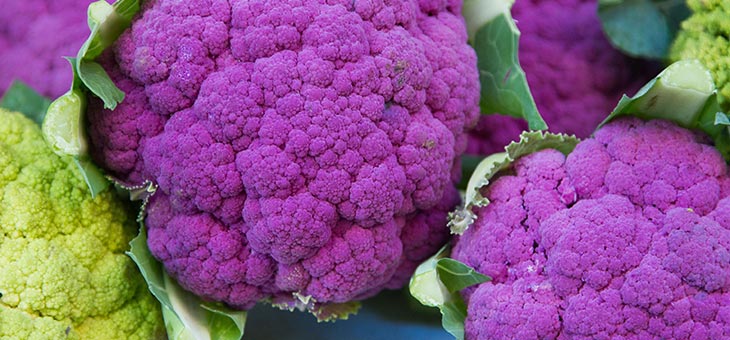Purple vegetables are certainly eye-catching – from black tomatoes and capsicums to deep violet climbing beans, and mauve cauliflowers to plum-coloured carrots. These colourful veg have an air of the unusual.
Whether you want to add a dark contrast to lighter shades in your flower border, or just want to create more interest in your vegetable patch or on your plate, here’s a selection of purple candidates worth considering.
1. Tomatoes
Have you ever seen a more gorgeous color on a tomato?.#tomato #indigorose #gardening #nofilter https://t.co/PZA4w5mGo2 pic.twitter.com/33M37Yt34x
— Gen X Amy (@simplyamybeth) June 29, 2018
The common colour is red and there are increasingly shades of yellow available, but many dark purples have also come onto the market to add drama to your summer salads.
Among them is tomato ‘Cosmic Purple’, which is almost black. If you want to plump for an American heirloom variety, you could do worse than ‘Purple Cherokee’, a large-fruited variety first recorded over 100 years ago, and thought to be originally grown by the Cherokee Indians.
Good to know: check what type of tomato it is before buying. If you have a small space, a compact bush tomato you can grow in a pot might be preferable, as you don’t have to pinch out the side shoots to keep growth in check, and many are small cherry types – although they are likely to need some support. For larger areas, you could go for a cordon type (single stemmed, requiring a single cane).
Read: Nine powerhouse vegies you should be eating
2. Carrots
View this post on Instagram
Nowadays, carrots are commonly orange – but the purple variety is here to stay, with recommended varieties such as ‘Purple Sun’ or ‘Deep Purple’ being widely available from most seed specialists.
Good to know: scrub purple carrots rather than peeling them, and eat them raw to retain the antioxidants in the coloured skin.
Read: Everything you need to know about flavonoids
3. Broccoli
#purplesproutingbroccoli is fabulously abundant in the allotment right now, but will go over within weeks. Is there any better vegetable to grow for cropping right now?https://t.co/5aquzzsAaV#allotmentlife #vegetablegarden #homegrownveggies #growyourown #growyourownfood pic.twitter.com/XgxoFZFXJI
— Mr Fothergills Seeds (@mrfothergill) April 28, 2021
Purple sprouting broccoli is expensive in the supermarket, yet easy to grow – and packs a colourful punch with its rich purple florets.
4. Cauliflower
View this post on Instagram
Purple cauliflowers will zing up your vegetable patch and create a talking point around the dinner table, especially if you use the florets raw in salads and as crudités for dips.
The colour comes from anthocyanins – the antioxidants found in red wine – making purple cauliflower more nutritious.
Good to know: sprinkle the purple florets with lemon juice before cooking, to retain the colour.
5. Asparagus
View this post on Instagram
Those delicious green spears now have additional shades of purple. Try ‘Phantom Purple’ – stringless spears that are tastier than some green varieties. Steam them lightly or eat them raw, to stop the colour being lost in overcooking.
Good to know: if you’re attempting to grow asparagus, you need to be patient as you’ll have to wait around three years if you want a good crop. Don’t cut the spears in the first or second years, to allow the plants to build up strength for the future.
6. Potatoes

You can now cut into both regular potatoes and sweet potatoes to find purple flesh. It’s admittedly a bit weird cutting into a potato and finding deep violet-coloured flesh, but if you can get past the colour of this early main crop, it makes a good jacket or salad potato.
Robust purple sweet potatoes are thick and oval shaped, and packed with excellent flavour as well as vitamins A, C, and B6.
Good to know: the attractive colour of many purple potatoes remains after cooking to jazz up your dinner.
Read: How to turn potatoes into a health food
7. Eggplant

While these impressive vegetables tend to be almost black-skinned, you can grow lighter purple varieties. Eggplant ‘Thai Purple Ball’ for example, is an unusual-looking variety producing a harvest of round purple fruits that are delicious roasted, sautéed or baked. It’s compact, so ideal for pots on a sunny patio if you’re short of space.
8. Beans and peas
View this post on Instagram
Whether you want purple flowers or fruits, seed companies can provide you with a wealth of choices. One such choice is the ‘Purple King’ variety. Beans give excellent yields for the space they occupy and this one is no different, except in colour! An outstanding variety, ‘Purple King’ has long flat dark purple beans that turn a deep green when cooked.
What’s your favourite purple vegie? Why not tell us in the comments section below?
– With PA
If you enjoy our content, don’t keep it to yourself. Share our free eNews with your friends and encourage them to sign up.

